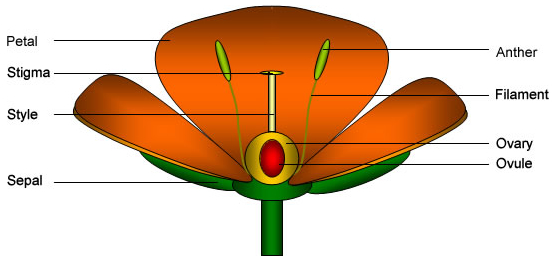Stucture of a 'typical' flower
A typical flower is about as common as a typical person – you have probably not met one yet, but it is useful in helping us understand basic flower structure. So, what do the different bits do?

Anther – produce the pollen.
Filament – hold the anther up in the flower in such a way that pollen can be brushed onto visiting insects.
Nectary – produce a sugary liquid that is like aviation fuel for flying insects and are usually located so an insect has to squeeze past the anthers and stigma to get at the nectar.
Ovary – is where the pollen tube grows down to – it may hold one or more ovules.
Ovule – the egg awaiting fertilization by the genetic information traveling down the pollen tube.
Petals – advertise that food is available – some even have guide marks that insects can see which act almost like a landing strip!
Sepal – can be green or coloured depending on whether they protect the flower bud only or also help with the advertising that the petals do.
Stigma – is the female bit where pollen ends up – a variety of mechanisms exist that will only allow pollen from another plant of the same species to go any further.
Style – holds up the stigma and is the path down which the pollen grain grows a tube.
Pollen and Nectar
Pollen not only carries genetic information from the male to the female parent plant, it also needs to be attractive as food to insects so they go looking for it. Insects are only interested in pollen as food. Pollen is rich in protein, the building blocks of growing cells and also contains fats, starches and vitamins – everything a growing insect needs! Most insects eat the pollen while they are visiting the flower, but honeybees (Apis mellifera) and bumblebees (Bombus spp.) take it back to the hive as food for their larvae. The collection of large pollen loads is one of the reasons that bees and bumblebees are such effective pollinators.
Nectar is a sugar-rich liquid produced by flowers and used by insects as ‘aviation fuel’, but it is of limited use for insect growth since it contains only small amounts of protein. It is harder for plants to get nitrogen than carbon, so using carbon-rich nectar rather than nitrogen-rich pollen as a reward makes sense. If nectar is available and the visiting insect is only interested in an energy snack, pollen is less likely to be eaten, meaning less can be produced to achieve pollination, placing less strain on valuable nitrogen resources.
How much nectar is offered as a reward depends on a trade-off. Nectar production uses energy and resources. If too much is produced, insects may not visit enough flowers to cross-pollinate. If not enough it produced, insects will not waste energy visiting. Bees measure distance in terms of energy used, so to be attractive to bees, flowers need to provide enough nectar to ‘fuel’ the flight of the bee while it collects pollen.
